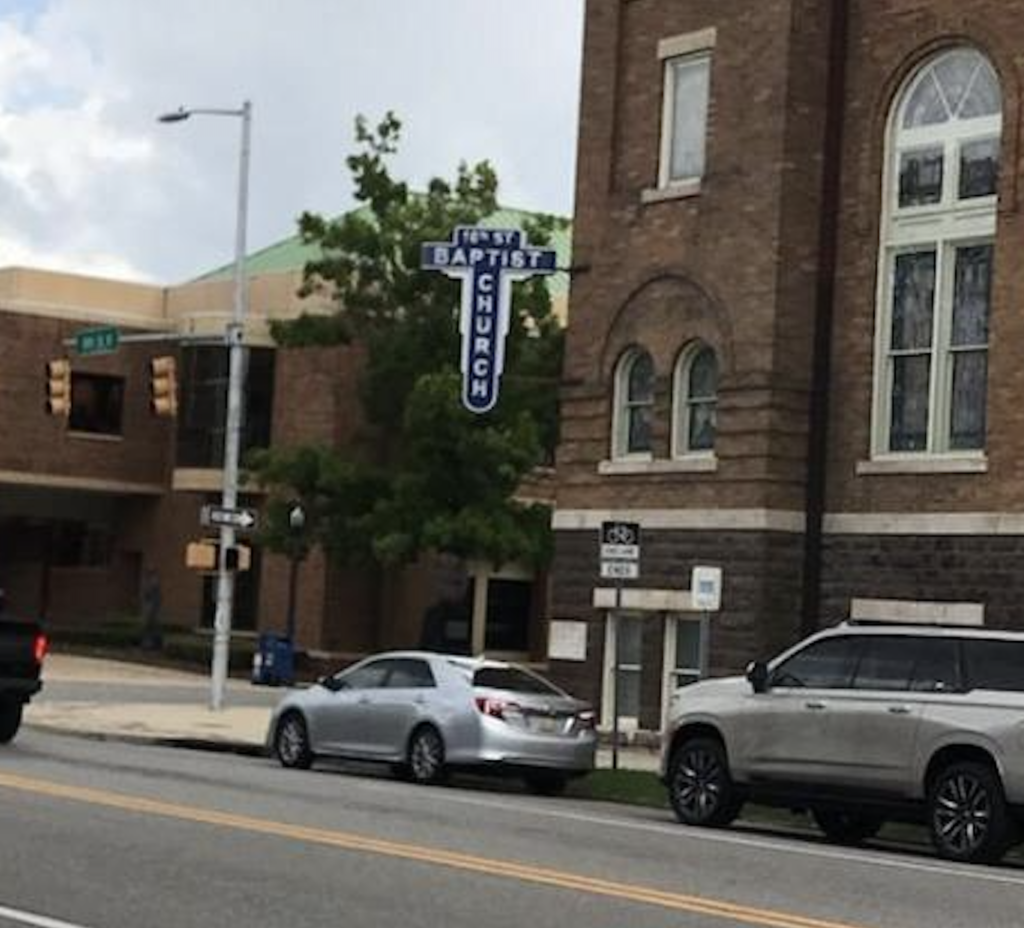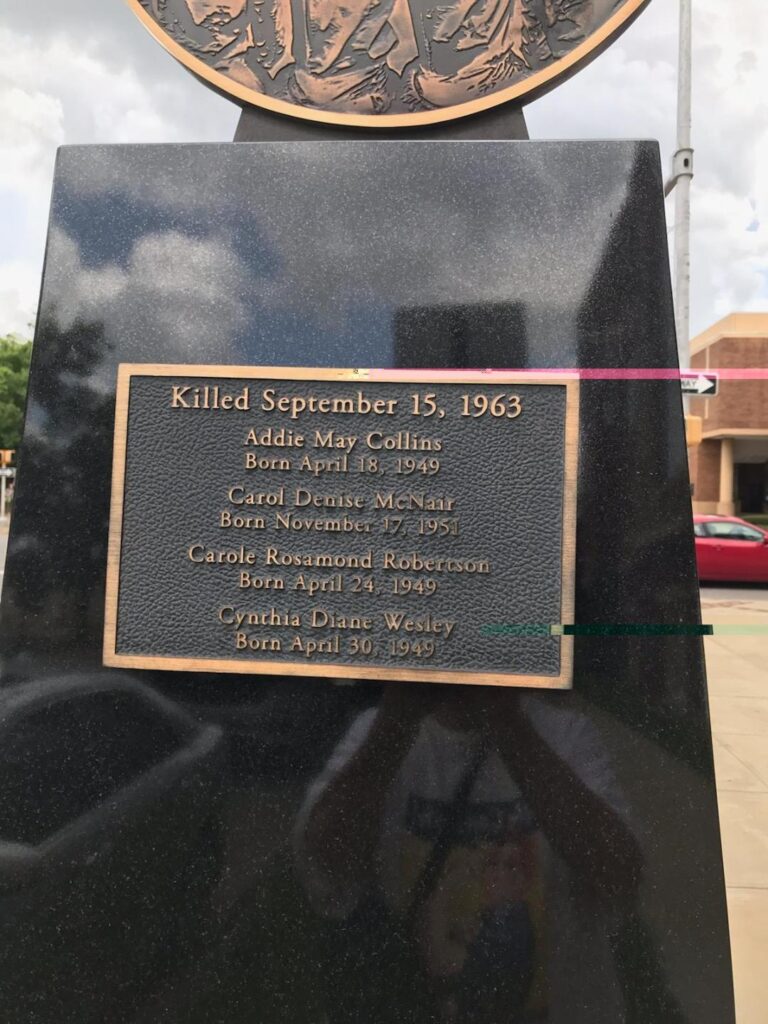The day did not start out well as my car battery was dead. Guess who helped me in the land of southern hospitality? Don’t hurt your brains guessing. A Black man and woman of course. He jumped the car and then I followed them to a Firestone where she knew the people and got me right in. In the waiting area, they had not one but two Bibles on display for those who hoped the carpenter was also a mechanic. An hour later, I was on the road only $235 worse off – or so I thought….
First stop was the 16th Street Baptist Church in Bombingham, Alabama. No that is not a typo. There were so many bombs in Birmingham that they started calling it Bombingham. This church was not the only bomb or the only church. Shuttlesworth’s Bethel church was also bombed as were people’s homes and places of business.
In addition to the well-known story of the four little girls who were murdered, I learned that two boys were also murdered that day: Johnny Crawford and Virgil Ware – one by the police and one by a carload of white teenagers just looking for someone to shoot. Virgil was top in his 8th grade class and wanted to be a lawyer (after my heart) but was buried in a grave by the side of the road until 2004 when he was reburied with a suitable monument and then in 2013 voted into the Black remembrance hall.
The first church on the site was a marvel of architecture and reminiscent of European churches. But because the white people didn’t like Blacks having a better-looking church than they did, tore it down claiming the steeples were too high. The congregation rebuilt it with a Black contractor and paid it off by 1940.
After the bombing, many congregations around the country took up collections and sent money to rebuild including the little church I went to in Muscoda, WI. When they rebuilt, they eliminated the steps under which the bomb had been planted and the door into the church and changed the bathroom where the girls were murdered into the kitchen.
The bombing of the church, the murder of the little girls, and the fire hoses and dogs aimed at the teenagers protesting afterward shocked the nation. We could no longer pretend the Black stories from the South weren’t true or were exaggerated. The current pastor said though it was a horrible thing, it was the beginning of the end for segregation. Bombing a church and murdering children, though it had been going on for centuries, was beyond the pale for most Americans when it was shown on TV.
From there, I drove to Selma part of the way in a driving rain. As you enter, there is a sign that says: Selma – Queen City of the Black Belt. It made my stomach turn. My photo of the Edmund Pettis bridge did not take and the interpretative center there was ringed by construction fencing. It did look disreputable and in need of repairs.
The Edmund Pettis bridge was the famous starting point in 1965 for the Bloody Sunday attempted march from Selma to Montgomery, the capital, by 600 people to demand voting rights. It’s where teenager John Lewis, future Congressman, was nearly beaten to death for doing what we have a constitutional right to do – protest. On Turnaround Tuesday, March 9, 2,000 marchers including many pastors from around the country joined the march. They stopped on the far side of the bridge, knelt and prayed. Still that evening Rev. James Reeb was murdered on the streets of Selma. On March 21, 4,000 people marched across the Edmund Pettis bridge on their way to Montgomery. President Lyndon Johnson had nationalized 1,890 Alabama National Guard who stood mostly silently along the sides of the road. They were backed up by 1,900 Army soldiers, 100 FBI, and 100 Department of Justice employees.
I then drove the route they walked on Highway 80. My first stop was the Lowndes Interpretative Center. Due to car problems I arrived at 4:30 when they closed at 5 so it was a quick run through. Lowndes is called the bloodiest county in Alabama which was verified by my visit to Legacy Museum in Montgomery the next day. Lowndes had 17 lynched people listed on their block. The only one with more was Monroe with 18. Driving, one could see this is a county with money. The large exurban homes were grand with flowing manicured lawns. At one home, the husband had put a sign “caution wife turning into driveway.” I did not find it funny.
At the entry to the Center, they had a white board asking if the Edmund Pettis bridge should be re-named for John Lewis. I had heard of this controversy and arguments both ways. Most on this board said yes or to put both names and show the movement from Klan leader (Pettis) to Freedom Fighter (Lewis).
Lowndes was built on the tent cities location which I knew nothing about. After the 1965 Voting Rights Act, Blacks flocked in droves to register to vote. For those who did, farmers evicted tenants, businessmen fired their workers, and the county took away land Blacks had owned – all to punish them for registering to vote. So with the help of SNCC, they erected a tent city and lived there for over a year.
On the walk to Montgomery, they stopped and camped four times. All four are memorialized by historical markers along the highway as is the Viola Liuzzo memorial where they murdered her on Route 80. I cried halfway to Montgomery. It is incomprehensible how Blacks kept up their spirits and kept fighting in the face of George Wallace and Bull Connor and firings and evictions and murders and lynchings.
But for the southerners, they can’t avoid what they did anymore. Signs are everywhere. Road signs, historical signs, civil rights institutes and museums and relics.
But then they have their civil war relics too. Statues of treasonous generals, the confederate flag, and road signs to “first capital of the confederacy.” They started constructing a wave of civil war statues and signs after the civil rights movement not before. So their aim, unlike the Germans, was not to remember the evil so to not repeat it, but to counter the evil and deny it. They had learned nothing.


